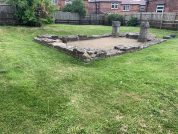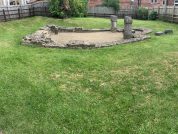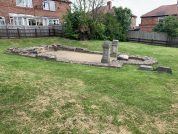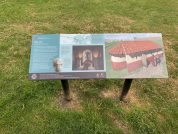Temple of Antenociticus
Roman Temple Or Shrine
This apsidal temple, probably dedicated to a local god, is situated about 100 yards outside the south-eastern defences of the Condercum fort, and is perfectly aligned north-south. This small, rectangular building measures some 15 feet east-west by 20 feet north-south, with an apse extending a further six feet to the south, wherein was placed a life-sized statue of the god. Probably built in the second century, the original northern doorway was blocked sometime in the third and replaced by a door inserted into the east wall. This god is not mentioned on any known Roman altarstones from the continent, and is therefore thought to be a native British deity.
RIB 1327 - Altar dedicated to Antenociticus and to the Divinities of the Emperors
To the god Antenociticus and to the Divinities of the Emperors Aelius Vibius, centurion of the Twentieth Legion Valeria Victrix, willingly and deservedly fulfilled his vow.
ANTENOCITICO
ET NVMINIB
AVGVSTOR
AEL VIBIVS
𐆛 LEG XX V V
V S L M
See also RIB 1328, 1329.
RIB 1328 - Altar dedicated to Antenociticus
Sacred to the god Antenociticus: the First Cohort of Vangiones, under the command of … Cassianus, prefect, willingly and deservedly fulfilled its vow.
SACRVM
COH I VA[...]GION
QVIB PRAE EST
[...]C CASSI
[... ]RAEF
[...] M
See also RIB 1327, 1329.
RIB 1329 - Altar dedicated to Anociticus
To the god Anociticus Tineius Longus (set this up) having, while prefect of cavalry, been adorned with the (senatorial) broad stripe and designated quaestor by the decrees of our best and greatest Emperors, under Ulpius Marcellus, consular governor.
IVDICIIS OPTIMO
RVM MAXIMORVM
QVE IMP N SVB VLP
MARCELLO COS TINE
IVS LONGVS IN P[...]
FECTVRA EQVITV[...]
LATO CLAVO EXORNA
TVS ET Q D
See also RIB 1327, 1328. 2–4. Optimi Maximique Imperatores: probably Marcus Aurelius with Commodus A.D. 177-180 (PIR¹ V no. 557). 4–5. Ulp(io) Marcello: consular governor of Britain, A.D. 177-84. The shrine containing these two altars (RIB 1327 and 1329), demolished when they were overturned, contained no coin later than Marcus Aurelius and was therefore presumably destroyed in A.D. 197 (Simpson and Richmond, Arch. Ael. 4th Ser. 19 (1941) 39 n. 136). In this case the joint emperors must be Marcus Aurelius and Commodus (see Atkinson, JRS 12 (1922) 68 no. 29). This will carry the governorship of Ulpius Marcellus back at least to the autumn of A.D. 180 as quaestors were designated for the forthcoming December on 23 January (Mommsen, Römisches Staatsrecht, ed. 3, i 590). Although Birley (in Askew Coinage 81 no. 31) cites Dio lxxii 8 as evidence for an unknown governor in A.D. 181, Dio’s phrase στÏατηγόν τινα μετὰ τῶν στÏατιωτῶν κατακοψάντων is more likely to refer to a less important officer, probably a legionary legate. Addenda from RIB+add. (1995): Ulpius Marcellus is now attested as governor of Britain on 23 March 178 (and by implication since at least 177) under two Emperors, Marcus Aurelius and Commodus: the evidence is a new military diploma published by Roxan, Roman Military Diplomas 1985-1993 (1994), 308-10 No. 184, who discusses the problem raised by Cassius Dio lxxii 8, that Marcellus was still (or once again) governor of Britain in 184. See also Birley Fasti, 140-2, 164-6, where the hypothesis of a ‘second’ Ulpius Marcellus must now be abandoned.
References for Temple of Antenociticus
- Hadrian’s Wall Map and Guide by the Ordnance Survey (Southampton, 1989);
- Hadrian’s Wall in the Days of the Romans by Ronald Embleton and Frank Graham (Newcastle, 1984) pp.51-57;
- The Roman Military Diet by R.W. Davies, in Britannia ii (1971) pp.122-142;
- Temples in Roman Britain by M.J.T. Lewis (Cambridge 1966);
- The Roman Inscriptions of Britain by R.G. Collingwood and R.P. Wright (Oxford 1965).
Roman Roads near Temple of Antenociticus
Wall: E (2) to Pons Aelivs (Newcastle, Tyne & Wear) Wall: W (7) to Vindobala (Rudchester, Northumberland)
Sites near Temple of Antenociticus
- Hadrian's Wall - Fort - Benwell (Condercum) (0 km)
Bath House, Hadrian's Wall Fort and Vicus - Benwell (Condercum) Vallum Crossing (0 km)
Hadrian's Wall - Benwell (Condercum) Vicus (0 km)
Vicus - Hadrian's Wall - Milecastle 6 - Benwell Grove (1 km)
Hadrian's Wall Milecastle - Hadrian's Wall - Milecastle 7 - Benwell Bank (1 km)
Hadrian's Wall Milecastle - Hadrian’s Wall – Turret 7b – Denton Hall (2 km)
Hadrian's Wall Turret - Hadrian's Wall - Milecastle 5 - Quarry House (2 km)
Hadrian's Wall Milecastle - Hadrian's Wall - Milecastle 8 - West Denton (3 km)
Hadrian's Wall Milecastle - Hadrian's Wall - Milecastle 4 - Westgate Road (3 km)
Hadrian's Wall Milecastle - Hadrian's Wall - Fort - Newcastle (Pons Aelius) (3 km)
Hadrian's Wall Fort and Roman Bridges



